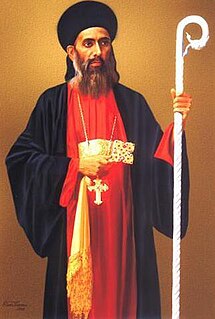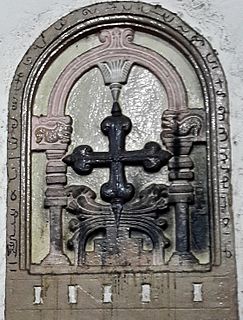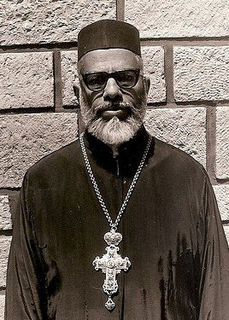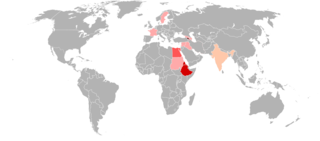
Eastern Christianity comprises Christian traditions and church families that originally developed during classical and late antiquity in Western Asia, Northeast Africa, Eastern Europe, Southeastern Europe, Asia Minor, the Malabar coast of South Asia, and parts of the Far East. The term does not describe a single communion or religious denomination.

The Malankara Orthodox Syrian Church (MOSC) also known as the Indian Orthodox Church (IOC) or simply as the Malankara Church, is an autocephalous Oriental Orthodox church headquartered in Devalokam, near Kottayam, India. The church serves India's Saint Thomas Christian population. According to tradition, these communities originated in the missions of Thomas the Apostle in the 1st century. It employs the Malankara Rite, an Indian form of the West Syriac liturgical rite.

The Syriac Orthodox Church, officially known as the Syriac Orthodox Patriarchate of Antioch and All the East, and informally as the Jacobite Church, is an Oriental Orthodox church that branched from the Church of Antioch. The bishop of Antioch, known as the patriarch, heads the church, claiming apostolic succession through Saint Peter in the c. 1st century, according to sacred tradition. The church upholds Miaphysite doctrine in Christology, and employs the Divine Liturgy of Saint James, associated with James, the brother of Jesus. Classical Syriac is the official and liturgical language of the church.
Catholicos, plural Catholicoi, is a title used for the head of certain churches in some Eastern Christian traditions. The title implies autocephaly and in some cases it is the title of the head of an autonomous church. The word comes from ancient Greek καθολικός, pl. καθολικοί, derived from καθ' ὅλου from κατά and ὅλος, meaning "concerning the whole, universal, general"; it originally designated a financial or civil office in the Roman Empire. The name of the Catholic Church comes from the same word—however, the title "Catholicos" does not exist in its hierarchy.

Saint Geevarghese Mor Gregorios, popularly known as Parumala Thirumeni, was a Metropolitan of the Malankara Orthodox Syrian Church. Parumala Thirumeni became the first person of Indian origin to be canonised as saint. In 1947, the Malankara Orthodox Syrian Church declared Mar Gregorios as a saint, making him the first canonized Christian saint from India. In November 1987, the Syriac Orthodox Church canonized him as a saint.
Non-Chalcedonian Christianity comprises the branches of Christianity that do not accept theological resolutions of the Council of Chalcedon, the Fourth Ecumenical Council, held in 451. Non-Chalcedonian denominations reject the Christological Definition of Chalcedon, for varying reasons. Non-Chalcedonian Christianity thus stands in contrast to Chalcedonian Christianity.

Alphabetical list of Eastern Christianity-related articles on English Wikipedia
Eastern Orthodox Christianity in Ireland is the presence of Eastern Orthodox Christians in the Republic of Ireland. Within Ireland, there are several formally organized parishes belonging to various autocephalous churches, primarily the Russian Orthodox Church, the Ecumenical Patriarchate of Constantinople, and the Romanian Orthodox Church.

The Coptic Orthodox Church of Alexandria has several churches in Great Britain and Ireland under the jurisdiction of four diocesan bishops.

Christianity has been, historically, a Middle Eastern religion with its origin in Judaism. Eastern Christianity refers collectively to the Christian traditions and churches which developed in the Middle East, Egypt, Asia Minor, the Far East, Balkans, Eastern Europe, Northeastern Africa and southern India over several centuries of religious antiquity. It is contrasted with Western Christianity, which developed in Western Europe. As a historical definition the term relates to the earliest Christian communities and their long-standing traditions that still exist.

The Jacobite Syrian Christian Church (JSCC), or the Malankara Archdiocese of the Syrian Orthodox Church in India also known as Malankara Jacobite Syrian Orthodox Church, the Jacobite Syrian Church, and the Syriac Orthodox Church in India, is a catholicate based in Kerala, India, of the Syriac Orthodox Church of Antioch and part of the Oriental Orthodox Church. It recognizes the Syriac Orthodox Patriarch of Antioch and All the East as supreme head of the church. It functions autonomously within the church, administered by the Metropolitan Trustee, under the authority of the Maphrian of India, Baselios Thomas I. Following schism with the Malankara Orthodox Syrian Church, is currently the only church in Malankara that is directly under a Syriac Christian Antiochian hierarchy, claiming continuity to the 1665 schism. The church employs the West Syriac Rite Liturgy of Saint James.

The Malankara Church, also known as Puthenkur and more popularly as Jacobite Syrians, is the historic unified body of West Syriac Saint Thomas Christian denominations which claim ultimate origins from the missions of Thomas the Apostle. This community, under the leadership of Thoma I, opposed the Padroado Jesuits as well as the Propaganda Carmelites of the Latin Church, following the historical Coonan Cross Oath of 1653. The Malankara Church's modern-day descendants include the Jacobite Syrian Christian Church, the Malankara Orthodox Syrian Church, the Malankara Marthoma Syrian Church, the Malabar Independent Syrian Church, the Syro-Malankara Catholic Church and the Saint Thomas Anglicans of the Church of South India.

The Oriental Orthodox Churches are a group of Eastern Christian churches adhering to Miaphysite Christology, with a total of approximately 60 million members worldwide. The Oriental Orthodox Churches are broadly part of the trinitarian Nicene Christian tradition shared by today’s mainstream churches, and represent one of its oldest branches.

Vilakuvelil Cherian Samuel, called Samuel Achen was an Indian Christian philosopher, scholar, university professor, theologian, historian, polyglot and ecumenical leader. He was a priest of the Indian Orthodox Church. He was the author of many doctrinal books and papers including The Council of Chalcedon Re-Examined: Historical Theological Survey.

E. A. E St. Mary's Soonoro Syriac Orthodox Church, Meenangadi, is a Marian Pilgrim center of the Syriac Orthodox Church located at Meenangadi in Kerala, India. The church is under E.A.E Arch Diocese, the first missionary association of Syriac Orthodox Patriarchate of Antioch and All the East, and is currently under the direct control of Ignatius Aphrem II, Patriarch of the Syriac Orthodox Church. In 2006, the church was elevated to the status of "Marian Pilgrim Centre", and in 2018, it celebrated its diamond jubilee. It is the first church to adopt the 8 Day Lent in Malabar Region.

The Holy Girdle, also known as the Girdle of Thomas, Holy Girdle of Mary, Holy Zoonoro, (or) Zunoro, and Holy Belt of Saint Mary the mother of Jesus, is a relic of the Blessed Virgin Mary which is one of the important relics of Syriac Orthodox Church and venerated by Oriental Orthodox communion. The word Zunoro is also translated as "belt", "sash" or "girdle". It is the Oriental Orthodox equivalent of the Girdle of Thomas in the Catholic Church, and the Cincture of the Theotokos in the Eastern Orthodox Church, now located at Mount Athos.
St. Mary's Church or Marth Maryam Cathedral is a valiyapally of the Syriac Orthodox Church situated in Kothamangalam town in the Ernakulam district of Kerala, India.

Oriental Orthodoxy in North America represents adherents, religious communities, institutions and organizations of Oriental Orthodox Christianity in North America, including the United States, Canada, Mexico and other North American states. Oriental Orthodox Christians in North America are traditionally organized in accordance with their patrimonial ecclesiastical jurisdictions, with each community having its own structure of dioceses and parishes. Most Oriental Orthodox Christians in North America belong to Armenian, Coptic, Ethiopian, Eritrean, Indian, Syriac and some other communities, representing religious majority or minority within a particular community. Oriental Orthodox jurisdictions are organized within the Standing Conference of Oriental Orthodox Churches.

Oriental Orthodox Churches are the churches descended from those that rejected the Council of Chalcedon in 451. Despite the similar name, they are therefore a different branch of Christianity from the Eastern Orthodox. Oriental Orthodoxy consists of several autocephalous and autonomous jurisdictions holding a single set of beliefs and united in full communion. However, they each have their own separate rites, and there are significant differences between their respective practices. Thus, there is more internal diversity of practice among the Oriental Orthodox than among the Eastern Orthodox.













